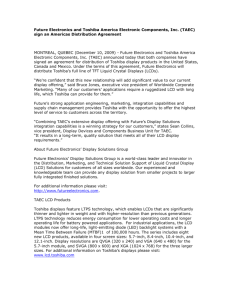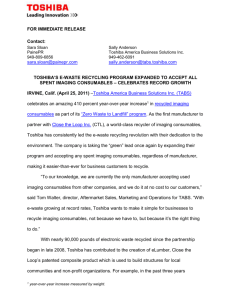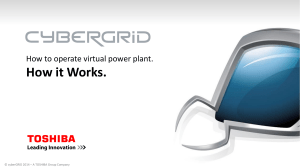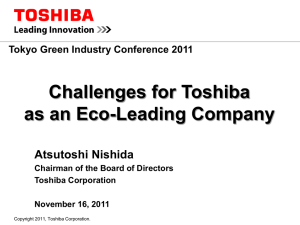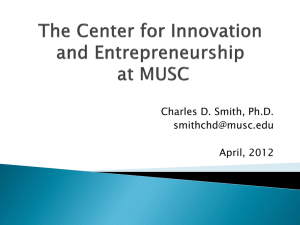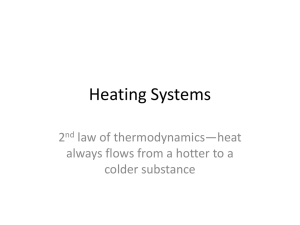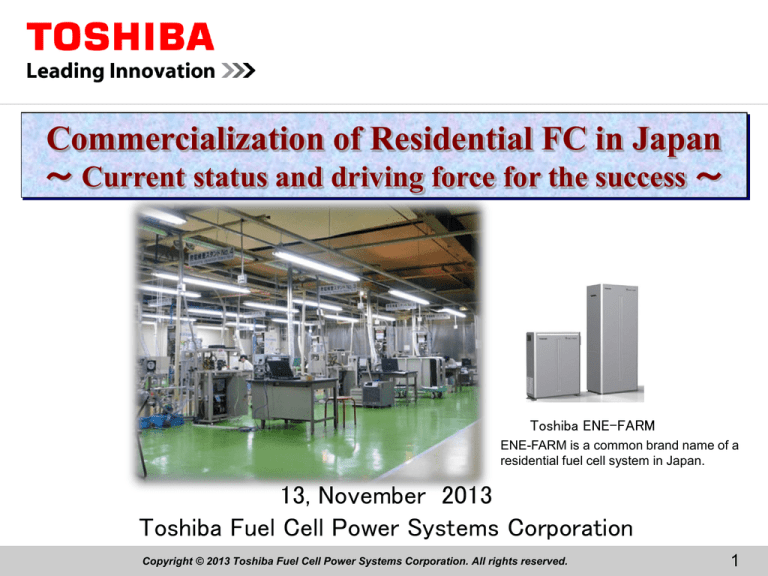
Commercialization of Residential FC in Japan
~ Current status and driving force for the success ~
Toshiba ENE-FARM
ENE-FARM is a common brand name of a
residential fuel cell system in Japan.
13, November 2013
Toshiba Fuel Cell Power Systems Corporation
Copyright © 2013 Toshiba Fuel Cell Power Systems Corporation. All rights reserved.
1
1. General Approach of Residential PEFC in Japan
2. Outline of Toshiba Activity to Residential PEFC
3. Summary
Background of Successful Commercialization
Copyright © 2013 Toshiba Fuel Cell Power Systems Corporation. All rights reserved.
2
History and Plan of ENE-FARM Commercialization in Japan
After technology verification and large scale monitoring program, Japan started
initial commercialization of 1kW class residential PEMFC “ENE-FARM” in
FY2009. Around 50,000units are now operated in Japanese household.
2009
FY2000~
General
Technology
Technology
verification
verification
Scheme
FY2005~
Introduction
Introduction
FY2010~
FY2020~
Popularization
Popularization
Real
Real
CommercialCommercialization
ization
FY2020 10GW
for Stationary
Progress
FY2002-FY2002
Fieldtest
test
Field
Future
Scenario
(Possible Image
for future)
FY2005-2008
FY2005-2008
Large
Scale
Extensive
Extensive
Monitoring
demonstration
PJ
demonstration PJ
From Verification
to Market
Introduction
by ENE-FARM
Enlarge market size with cost
reduction by mass production
& technology breakthrough
Introduction:
Several k-units
to several ten k-units
Establishment:
several ten k-units
to several hundred k-units
Real Commercialization: More than
several hundred k-units
Copyright © 2013 Toshiba Fuel Cell Power Systems Corporation. All rights reserved.
3
Large Scale Monitoring Program by Japanese Government
Five system manufacturers joined
to the program, and delivered
3,307units.
Toshiba delivered 748 units among
them.
The Amount of CO2 Reduction [kg/month]
In advance of commercialization, over 3,300unit of residential PEFC were
installed and verified in FY2005 through 2008 under governmental program. In
the program, system showed enough performance and reliability as future
commercial product.
Thermal Load of each House [MJ/month]
Residential PEFC showed the
performance to reduce 100kg/month
of CO2 as the average.
Copyright © 2013 Toshiba Fuel Cell Power Systems Corporation. All rights reserved.
4
Status of ENEFARM Dissemination
Trend of sales volume
Start commercialization
Sales started in 2009 with the
declaration by government and energy
companies on January, 28, 2009.
[Annual volume]
The sales volume has been
increased year by year. Accumulated
volume is expected to be more than
40,000unit in FY2012
25
20
20
12
15
10
5
5
2009
2010
5
0
2011
2012
2013
[Fiscal year]
* the volume of 2012 is roughly
estimated based on subsidy
condition as of end of August
Copyright © 2013 Toshiba Fuel Cell Power Systems Corporation. All rights reserved.
5
1. General Approach of Residential PEFC in Japan
2. Outline of Toshiba Activity to Residential PEFC
3. Summary
Background of Successful Commercialization
Copyright © 2013 Toshiba Fuel Cell Power Systems Corporation. All rights reserved.
6
History of Stationary Fuel Cell in Toshiba
Toshiba FCP started PEFC development in FY2000 and is about to reach real
commercial stage in FY2012.
1999 2000 2001 2002 2003 2004 2005 2006 2007 2008 2009 2010 2011 2012
Millennium PJ
NEF・IBEC test
NEF Large Scale Demo Prg.
NEF LSDP
First model
FY2005
NEF LSDP
Final model
Introductory support subsidy
Initial
Commercial
model
FY2007
Real
Commercial
model
FY2009
28 years experiments of PAFC development in Toshiba
1980
1990
50kW Pilot plant
2000
TEPCO 11MW Plant(23k hrs.)
Onsite 1MW Plant(16khrs).
NEDO1MW Plant
Onsite 200kW PC25C
Copyright © 2013 Toshiba Fuel Cell Power Systems Corporation. All rights reserved.
7
2nd Generation Model of Toshiba ENE-FAEM (TM1-AD)
The highest energy saving
“1.5ton/year”
The higher total efficiency
“94% Total (39%E & 55&H)
High value added
“GI capability w/o battery”
Cost competitiveness
“Leading cost reduction among
Japanese ENEFARMs”
The longest durability
“80k hrs w/o CSA replacement”
Higher maintenance capability
“3.5yrs maintenance interval.
Work w/o system shut down”
Fuel diversity and its tolerance
“Already delivered commercial
units in Japan”
Easier installation
“Lighter and smaller system”
Copyright © 2013 Toshiba Fuel Cell Power Systems Corporation. All rights reserved.
8
Cost reduction approach
“REDUCE” was one of core concept in accelerating the cost reduction.
30% of cost reduction was achieved with technology approach.
Reformer
・Optimize catalyst
FC unit
・Minimize length of welding
System / Package:
・Simplify system
・Apply multi module
piping
Module pipe
・Apply low cost BOP
Inverter & Controller
・High performance one
integrated to single board
FY2011
New
CSA
・Reduce cell number (15%)
・Reduce catalyst (20%)
・Apply low cost material
CSA
Copyright © 2013 Toshiba Fuel Cell Power Systems Corporation. All rights reserved.
9
Successful shifting to commercialization in Toshiba PEFC
Development
•>35% Electric / >85% Total Efficiency
•System durability longer than 70kh
•Reliability better than 5% annual failure rate
•Significant CR (to 1/8 level through 5years)
•Tolerant system for raw fuel (NG & LPG)
•Light weight for installation (104kg)
•Low noise design (<40dB)
Verification
•Delivered around 800units since 2005 until 08
•The longest units recorded 30kh in real field
•Total fleet operation time to be 10million hrs
•CO2 reduction to be 1.2-1.4t/year
•Reliability potential for commercialization
4,200
Commercialization readiness
•Preparing production process
•Maintenance and sales channel with energy companies
•Getting Japanese certification
Cost reduction results
Performance improvement of
components
System simplification
Manufacturing process
improvement
価格(%)
Relative
Cost
100%
Another 17% CR
Further cost reduction
Cost reduction after
by massFY2009
80%
60%
production
Manufacturing process
improvement
1/2
40%
1/3
1/4
20%
1/6
1/8
10000
Large scale demo.
⇒ Initial commercialization
Cost reduction trend to 1/8 level withy 5years activity
(12,388)
8000
6000
4,122
4000
2,557
1,655
2000
0%
FY2008
FY2009 FY2009
FY2010 FY2011
FY2004
FY2005 06年(216台)
FY2006
FY2007
FY2008
04年(開発機)
05年(140台)
07年(204台)
08年(203台)
09年(1500台)
Development Phase
⇒
Significant volume
increase after initial
commercialization
12000
125
216
204
203
0
FY2005 FY2006 FY2007 FY2008 FY2009 FY2010 FY2011 FY2012
2013
Sales volume increase of Toshiba ENEFARM
Successful shifting from development phase to commercialization over death valley!
Copyright © 2013 Toshiba Fuel Cell Power Systems Corporation. All rights reserved.
10
Business and Market Expanstion toward the future
Various application offers the possibility to expand ENE-FARM market and business toward the future.
-20degC ambient
HEMS、Smart grid with PV and Battery
Continuous improvement of ENE-FARM as core product
(cost, performance, reliability and durability and maintainability)
Offering and preparing wider application to expand the market
(HEMS, expanded GI option, fuel diversity, option for colder area)
Copyright © 2013 Toshiba Fuel Cell Power Systems Corporation. All rights reserved.
11
1. General Approach of Residential PEFC in Japan
2. Outline of Toshiba Activity to Residential PEFC
3. Summary
Background of Successful Commercialization
Copyright © 2013 Toshiba Fuel Cell Power Systems Corporation. All rights reserved.
12
Key factors for the commercialization of residential PEM
( from IPHE Conference in 2011)
Residential PEM is on the commercialization phase
since 2009 in Japan!
3 Aspects
5 Factors
Collaboration among
Japanese companies FCCJ
Governmental
leadership
Technology potential of
manufacturers w/ long history
Collaborative development
under NEDO Project
[Core competence
in technologies]
Partnership with Energy
companies and manufacturers
[Governmental
efforts]
Copyright © 2013 Toshiba Fuel Cell Power Systems Corporation. All rights reserved.
[Company
collaboration]
13
~ Thank you ~
Copyright © 2013 Toshiba Fuel Cell Power Systems Corporation. All rights reserved.
14

